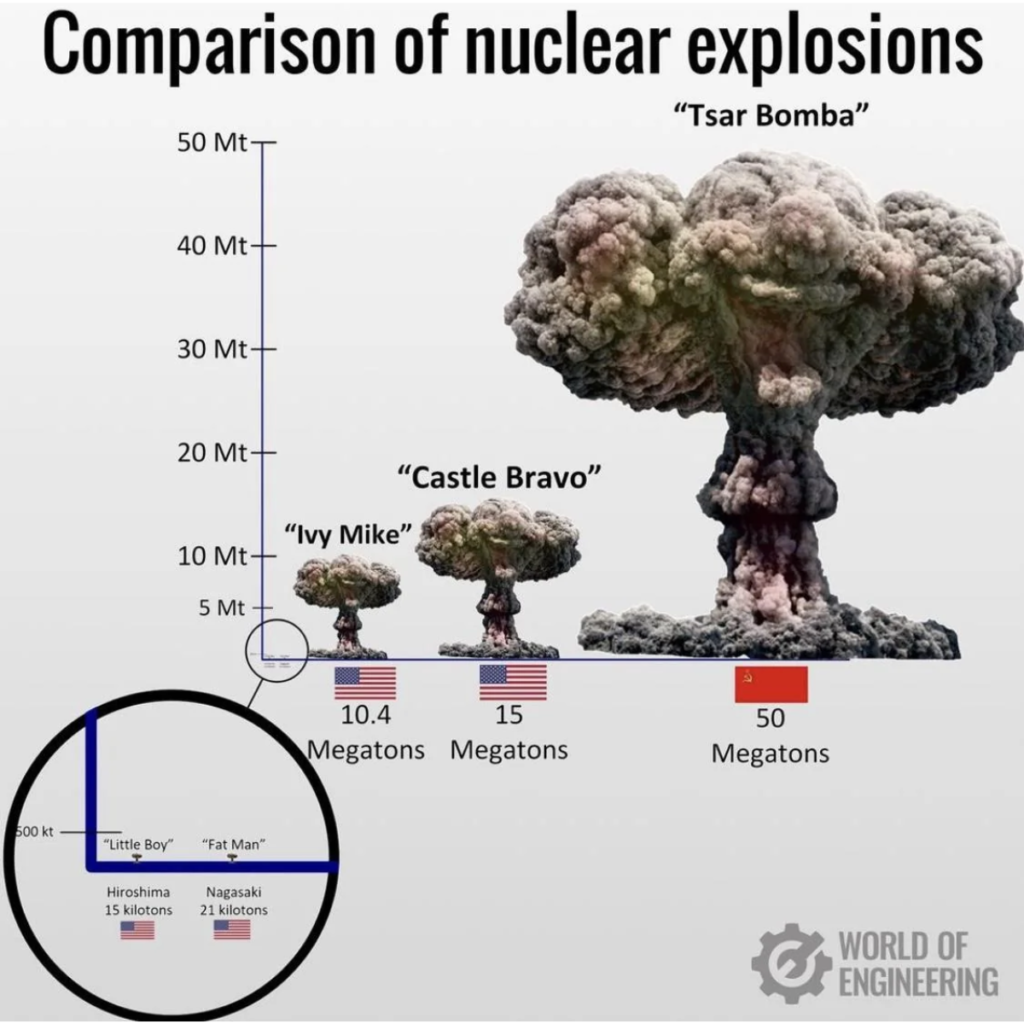
Atomic Bombs vs. Nuclear Bombs: What’s the Difference?

Both are capable of mass destruction. Here’s what you should know about each
The atomic bombs dropped on the Japanese cities of Hiroshima and Nagasaki at the end of World War II—codenamed “Little Boy” and “Fat Man,” respectively—caused widespread destruction, leveled cities, and killed between 90,000 and 166,000 people in Hiroshima (about 20,000 of which were soldiers), and between 39,000 and 80,000 in Nagasaki.
These are the only two nuclear weapons ever used in warfare, to date, and let’s hope it stays that way—because some of the nuclear weapons today are over 3,000 times as powerful as the bomb dropped on Hiroshima.
And there are new fears, stoked by the ongoing Russo-Ukrainian War, that Russian President Vladimir Putin could deploy nuclear weapons against the West. During a February 24 address to Moscow, Putin warned other countries that any attempt to intervene would lead to “consequences you have never seen,” which has been interpreted as a veiled threat of nuclear warfare.
Let’s return to the history of atomic weapons. The Little Boy and the Fat Man were atomic bombs, or fission bombs, which set off a chain reaction of nuclear fission. The atomic nuclei of radioactive materials were split to create different elements, which releases a large amount of energy, splitting more atoms as a result and producing a destructive explosion.
In the Little Boy, a bullet-like projectile made of uranium-235 was fired at a core of the same substance to set off the chain reaction. The Fat Man, on the other hand, used a core of plutonium-239 that was ignited with thousands of pounds of conventional explosives, again setting off a chain reaction of nuclear fission.
So, atomic bombs are a kind of nuclear bomb that only utilize nuclear fission. The other type of nuclear bombs are thermonuclear bombs, also known as hydrogen bombs, which use the process of nuclear fusion to some degree.
In a thermonuclear weapon, the fission process is only the beginning. Modern nuclear weapons, such as the United States’ B83 bombs, use a similar fission process to what is used in atomic bombs. But that initial energy then ignites a fusion reaction in a secondary core of the hydrogen isotopes deuterium and tritium. The nuclei of the hydrogen atoms fuse together to form helium, and again a chain reaction results in an explosion—this time a much more powerful one.
As the above video from YouTube channel RealLifeLore illustrates, the blast from the Little Boy released about 15 kilotons of energy, equivalent to 15,000 tons of TNT, and sent a mushroom cloud up to about 25,000 feet. The Fat Man produced an explosion of about 21 kilotons. The B83? 1.2 megatons, equaling 1,200,000 tons of TNT, making it 80 times more powerful than the Little Boy.
It gets even more terrifying than that. The largest nuclear weapon ever detonated, the Tsar Bomba, set off by the Soviet Union in 1961, produced an insane 50-megaton blast—about 3,333 times more powerful than the Little Boy bomb that leveled an entire city. The Tsar Bomba is the largest manmade explosion to date, sending a mushroom cloud up to more than 130,000 feet in altitude—about 4.5 times the height of Mount Everest—as it sent shockwaves around the globe three times over.
Curious to see how you’d fare in the event that a nuclear bomb were dropped on a big city near you? NUKEMAP, created by Alex Wellerstein, charts out the impacts of a nuclear blast on cities around the world. (It also maps out the waste laid by historic nuclear blasts such as the Trinity blast in New Mexico in 1945, and the 1961 Tsar Bomba blast in Novaya Zemlya, Russia.)
If we wanted to, we could build a bomb even more powerful than the Tsar Bomba. But maybe it’s time we start looking to use nuclear fusion for something else. How about a six-month round-trip to Mars instead?
